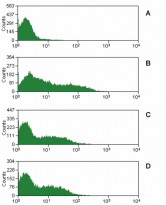ARG62741
anti-CD16 antibody [MEM-168]
anti-CD16 antibody [MEM-168] for Flow cytometry and Human,Primates,Pig
Developmental Biology antibody; Immune System antibody; General Lymphocyte Marker Study antibody; Natural killer cells antibody
Overview
| Product Description | Mouse Monoclonal antibody [MEM-168] recognizes CD16 |
|---|---|
| Tested Reactivity | Hu, NHuPrm, Pig |
| Tested Application | FACS |
| Specificity | The clone MEM-168 reacts with CD16 antigen, a low affinity receptor for aggregated IgG (FcgammaRIII antigen). CD16 exists in two different isoforms: CD16a (FcgammaRIIIA; 50-65 kDa; expressed on NK-cells, monocytes and macrophages) and CD16b (FcgammaRIIIB; 48 kDa; mainly expressed on neutrophils). |
| Host | Mouse |
| Clonality | Monoclonal |
| Clone | MEM-168 |
| Isotype | IgM |
| Target Name | CD16 |
| Antigen Species | Human |
| Immunogen | Human granulocytes |
| Conjugation | Un-conjugated |
| Alternate Names | FCRIIIA; FcRIIIa; CD antigen CD16a; Fc-gamma RIII-alpha; FCR-10; FcR-10; FCRIII; FCG3; Low affinity immunoglobulin gamma Fc region receptor III-A; FCGRIII; CD16; Fc-gamma RIIIa; IgG Fc receptor III-2; IMD20; CD16A; IGFR3; CD16a antigen; FCGR3; FcRIII; Fc-gamma RIII |
Application Instructions
| Application Suggestion |
|
||||
|---|---|---|---|---|---|
| Application Note | * The dilutions indicate recommended starting dilutions and the optimal dilutions or concentrations should be determined by the scientist. |
Properties
| Form | Liquid |
|---|---|
| Purification | Purified from ascites by gel filtration and precipitation methods. |
| Purity | > 95% (by SDS-PAGE) |
| Buffer | TBS (pH 8.0) and 15 mM Sodium azide |
| Preservative | 15 mM Sodium azide |
| Concentration | 1 mg/ml |
| Storage Instruction | For continuous use, store undiluted antibody at 2-8°C for up to a week. For long-term storage, aliquot and store at -20°C or below. Storage in frost free freezers is not recommended. Avoid repeated freeze/thaw cycles. Suggest spin the vial prior to opening. The antibody solution should be gently mixed before use. |
| Note | For laboratory research only, not for drug, diagnostic or other use. |
Bioinformation
| Database Links |
Swiss-port # P08637 Human Low affinity immunoglobulin gamma Fc region receptor III-A |
|---|---|
| Gene Symbol | FCGR3A |
| Gene Full Name | Fc fragment of IgG, low affinity IIIa, receptor (CD16a) |
| Background | CD16 (FcgammaRIII) is a 50-65 kDa glycoprotein serving as a low affinity IgG receptor. Human FcgammaRIII is expressed in two forms – FcgammaRIII-A and -B. FcgammaRIII-A is a transmembrane protein of monocytes, macrophages, NK cells and a subset of T cells. It is associated with FcepsilonRI-gamma subunit and is responsible for antibody-dependent NK cell cytotoxicity. Mast cell FcgammaRIII-A is associated, moreover, with FcepsilonRI-beta subunit. Besides IgG, FcgammaRIII-A can be triggered also by oligomeric IgE. FcgammaRIII-B is a GPI-linked monomeric receptor expressed on neutrophils and is involved in their activation and induction of a proadhesive phenotype. |
| Function | Receptor for the Fc region of IgG. Binds complexed or aggregated IgG and also monomeric IgG. Mediates antibody-dependent cellular cytotoxicity (ADCC) and other antibody-dependent responses, such as phagocytosis. [UniProt] |
| Highlight | Related products: CD16 antibodies; CD16 ELISA Kits; CD16 Duos / Panels; Anti-Mouse IgM secondary antibodies; Related news: Tumor-Infiltrating Lymphocytes (TILs) |
| Research Area | Developmental Biology antibody; Immune System antibody; General Lymphocyte Marker Study antibody; Natural killer cells antibody |
| Calculated MW | 29 kDa |
| PTM | Glycosylated. Contains high mannose- and complex-type oligosaccharides. Glycosylation at Asn-180 is mandatory for high affinity binding to the Fc and for discrimination between fucosylated and afucosylated IgG glycoforms. The soluble form is produced by a proteolytic cleavage. |
Images (1) Click the Picture to Zoom In
-
ARG62741 anti-CD16 antibody [MEM-168] FACS image
Flow Cytometry: Porcine peripheral blood.
Panel A. Stained with Isotype mouse IgM control, Panel B,C,D. three different porcine PMBC samples stained with ARG62741 anti-CD16 antibody [MEM-168], followed by incubation with FITC-labelled secondary antibody.






